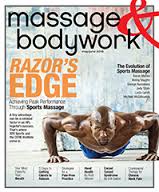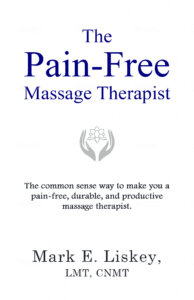Which is better to wear for COVID-19 eye protection when doing a massage, a face shield or goggles?
According to the CDC, both are adequate forms of eye protection for infection control.
The face shield offers the advantage of protecting more areas of the face, and it’s a physical barrier between the wearer’s hands and face, which can help protect against contact transmission, e.g. rubbing eyes.
(Go here to learn more about face shields and why massage therapists need eye protection during the COVID-19 era.)
The disadvantage with wearing a face shield is that it can make your head hot, especially if you’re double-masking when working, like I do.
Face shields can also look a little HAZMAT-y and not so massage-y.
So, I’ve been researching goggles as an alternative to face shields, and I found that all goggles are not equal for keeping the potential bad stuff out.
Before we get started with the CDC goggle recommendations for keeping the bad stuff out, let’s define what goggles are by saying what they’re not: They’re not safety glasses.
Goggles Versus Safety Glasses
Safety glasses provide impact protection and don’t provide the same level of splash/droplet protection as goggles do, according to this 3M technical bulletin. I also confirmed this when I talked to a 3M rep on the phone. So, from a pure being-as-safe-as-possible-in-the-massage-room perspective, we’re going to stick with goggles exclusively for this article.
Okay, we know what goggles are not, now we need to know which goggles can be used for PPE.
What to Look for When Buying Goggles for Infection Control
The CDC stated that goggles for infection control should be indirectly ventilated.
What’s indirect ventilation?
According to Albany County Fasteners, it is “the venting system that does not allow for direct contact of particles to the interior of the goggles. This is achieved by adding angled vents which face away from the front lens that the wearer looks through.”
Basically, indirect ventilation makes it harder for bad stuff to make it to the eyes.
The downside to a pair of indirect-vented goggles is that indirect-vented goggles won’t be as well ventilated as direct-vented goggles.
Hmm…a little warmer around the eyes versus less potential COVID…that’s a tough decision—not.
The CDC also recommends that the goggles should have an anti-fog coating, and that the goggles should “fit snugly, particularly from the corners of the eye across the brow.”
Fitting snugly doesn’t necessarily mean the goggles need to seal around the wearer’s eyes, according to 3M.
If in doubt as to whether the goggles you’re thinking about purchasing are resistant to liquid droplets/splash, look for or ask if the goggles have “3” marked on the frame. (EN 166:2001 Personal eye protection. Specifications. European Committee for Standardization, Brussels.).
So, let’s summarize what you want in a pair of massage goggles (eye protection for infection control).
Requirements for Goggles for Infection Control
- Indirect ventilation
- Anti-fog coating
- Snug fit especially from the corners of the eyes across the brow.
- When in doubt, look for “3” on the frame.
Seems pretty straightforward so far, right?
But here’s the twist: Have you ever tried a pair of standard goggles like the ones pictured below while you’re also wearing a N95 mask?
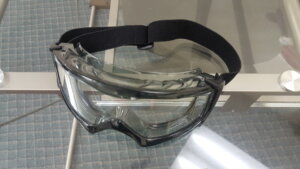
The N95 Challenge
Besides looking like I should be doing a science experiment instead of a massage, let me share my experience of wearing a N95 with the goggles pictured above.
Picture Mike Tyson. Now, imagine Iron Mike has one hand on the back of your head and his other hand is balled up in a fist and he’s pressing it into the bridge of your nose for 60 minutes.
In case you wanted to run the experiment yourself I’m just going to warn you that minute one of Mike Tyson pressing his fist into the bridge of your nose is bearable. It’s around minute 23 when you want to rip the goggles off your head.
The problem with wearing goggles, like the ones pictured above, with a N95 is that they both press on the bridge of the nose at about the same place.
Are there alternatives to the goggles pictured above?
Potentially.
We’ll circle back to that in a minute. First, we’re going to find goggle solutions for (1) cotton and 3-ply medical masks, then (2) N95s and, finally, (3) people with glasses.
Goggles When Wearing Cotton and 3-Ply Medical Masks
Cotton masks and 3-ply medical masks are typically easy on the bridge of the nose. So, there is built-in leeway with goggle style because you don’t need to be overly concerned about too much pressure on the bridge of your nose.
Here are 3M goggles that comply with the requirements of the European standard EN166.2001. By the way, the good thing about goggles is that they aren’t expensive and you can experiment with them without going broke.
Fahrenheit
Goggle Gear (GG) 500
2890 Series
4800 Series
Goggle Gear (GG) 6000
You can check these models out here.
You can also do your own Google search to find more goggles. Just keep in my mind indirect venting, anti-fog coating and a snug fit.
Okay, now if you’re like me and wear a N95 when doing a massage, let’s look at eye protection that won’t break our noses.
Goggles When Wearing a N95
First, it’s hard to determine which goggles might work well with a N95 from pictures and descriptions alone. So, I called the 3M tech department for a recommendation and the advisor suggested the Goggle Gear 500 series.
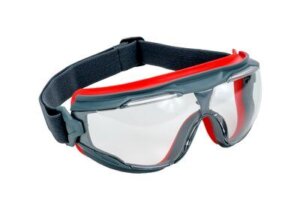
From the picture it looks like the GG 500 nose piece contacts the wearer’s nose higher up on the bridge of the nose when compared to the Fahrenheit, 2890, 4800, and 6000 models. That could mean that the wearer is not getting double pressure from the goggles and the N95 at the same place on the bridge of the nose. I’ve ordered the GG 500 to run the experiment and will update this article soon.
Here’s another potential option that looks really intriguing to me—the Magic5 swimming goggles converted into PPE.
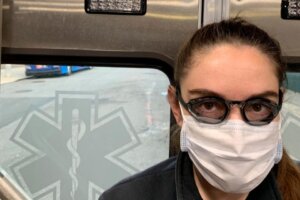
When COVID hit, and there was a shortage of PPE, the Magic5 company started turning their swim goggles into protective goggles.
From what I could discern on their website, they’re not claiming to meet CDC goggle criteria for infection control eye protection; however, the custom-fit Magic5 goggles seem to satisfy what I would argue to be the most important criterion: snug fit. In fact, their gasket fit is so snug, that it’s water-leak-proof (which you would hope to be the case with swimming goggles).
The Magic5 goggles also has a custom-fit nose bridge, and look at the picture above—see how high the nose bridge is? That could totally go above the N95 nose piece.
And call me vain, but after looking like a lab tech with my current goggles, I’m up for the Phelps look.
But before I place my order, I’m going to do a little more digging to see how compliant the Magic5 goggles are with CDC recommendations. I’ll update this article after I get more information.
UPDATE: I contacted Magic5 and they responded very quickly via email:
Mark,
Thanks for your voicemail.
In regards to your question about using goggles as PPE:
This is a tricky question to answer, and it kind of depends on the form of PPE you are looking for. In an impact protection eyewear setting, our goggles would not do very much. I am assuming you’re talking about using them in a medical setting in place of the large clear face shields.
Our goggles are not certified in any way to be considered medical grade PPE, however earlier this year when New York was dealing with a nationwide shortage of proper PPE, since our supply chain was not affected by the COVID-19 Pandemic at the time we were able to send a number of pairs of our goggles as a sort of “best case alternative”.
I am not sure if there are any particular guidelines about what constitutes proper PPE where you are, but if you are just looking for something other than a cloth face mask then they might be an ok solution for you. However, they do only cover the eyes.
Hope this helps! Please let me know if you have any other questions.
Best Regards,
Garen
THEMAGIC5
Yes, I was hoping for a slam-dunk yes answer, too, but, instead we have this: Not impact grade goggles. That’s fine. There should be no flying debris in a massage.
But they also are not certified medical grade goggles even though they were considered a “best case alternative” to eye protective PPE in New York during the 1st wave of the pandemic.
Personally, as the 2nd wave is coming on us, I’m sticking with the face shield.
Okay, we have goggles for cotton and disposable surgical masks. We have a potential goggle alternative (not medical grade) when wearing a N95. What if you wear glasses? How do you wear goggles and glasses at the same time?
Goggles with Glasses
You have two options here. You can get goggles with prescriptive inserts. Go here.
Or you can do what I do: Jettison your glasses and be a little blind in the massage room, which, I feel, adds to my palpation sensitivity.
Cleaning Your Goggles
No matter which option you choose or which goggles you get, you’ll need to know how to clean them. Here’s a more official recommendation from 3M: Go to page 4 of their Technical Bulletin in August, 2020.
I use soap and water or if I need to move with greater urgency, I use disinfectant wipes.
That’s it.
You’ve got goggle options for cotton masks and disposable 3-ply surgical masks: Fahrenheit, Goggle Gear (GG) 500, 2890 Series, 4800 Series, Goggle Gear (GG) 6000
You have this goggle recommendation for a N95 mask: 3M’s GG 5000. And the Magic5’s PPE conversion goggles are not medical grade, but were used during the pandemic as a best alternative.
And you have two options if you wear glasses: (1) get prescriptive inserts for your goggles or (2) jettison your glasses and just wear goggles in the massage room.
Work safe. Be healthy.
Join my email group and get my latest how to safe and keep your clients safe during Covid-19.



